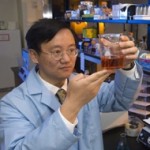
Researchers create food from non-food plants
By Food in Canada magazine staff
Business Operations Food Trends Research & DevelopmentScientists in the U.S. may have found a way to help feed the world’s growing population by transforming cellulose into starch
Blacksburg, Va. – Researchers at Virginia Tech may have found a way to help feed the world’s population, which is expected to swell to nine billion by 2050.
The researchers have created a potential food source from non-food plants by transforming cellulose into starch. The process has the potential to provide a previously untapped nutrient source from plants not traditionally thought of as food crops.
 Starch is one of the most important components of the human diet and provides 20 to 40 per cent of daily caloric intake.
Starch is one of the most important components of the human diet and provides 20 to 40 per cent of daily caloric intake.
The research was published this week in the Early Edition of the Proceedings of the National Academy of Sciences of the United States of America.
Y.H. Percival Zhang, an associate professor of biological systems engineering in the College of Agriculture and Life Sciences and the College of Engineering, led the team of researchers in the project.
What is cellulose?
Cellulose is the supporting material in plant cell walls and is the most common carbohydrate on earth.
This new development opens the door to the potential that food could be created from any plant, reducing the need for crops to be grown on valuable land that requires fertilizers, pesticides and large amounts of water.
The type of starch that Zhang’s team produced is amylose, a linear resistant starch that is not broken down in the digestion process and acts as a good source of dietary fibre. It has been proven to decrease the risk of obesity and diabetes.
This discovery holds promise on many fronts beyond food systems.
“Besides serving as a food source, the starch can be used in the manufacture of edible, clear films for biodegradable food packaging,” says Zhang. “It can even serve as a high-density hydrogen storage carrier that could solve problems related to hydrogen storage and distribution.”
Zhang used a novel process involving cascading enzymes to transform cellulose into amylose starch.
The new approach takes cellulose from non-food plant material, such as corn stover, converts about 30 per cent to  amylose, and hydrolyzes the remainder to glucose suitable for ethanol production.
amylose, and hydrolyzes the remainder to glucose suitable for ethanol production.
Corn stover consists of the stem, leaves and husk of the corn plant remaining after ears of corn are harvested. However, the process works with cellulose from any plant.
This bioprocess – called “simultaneous enzymatic biotransformation and microbial fermentation” – is easy to scale up for commercial production.
It is environmentally friendly because it does not require expensive equipment, heat, or chemical reagents, and does not generate any waste. The key enzymes immobilized on the magnetic nanoparticles can easily be recycled using a magnetic force.
Print this page